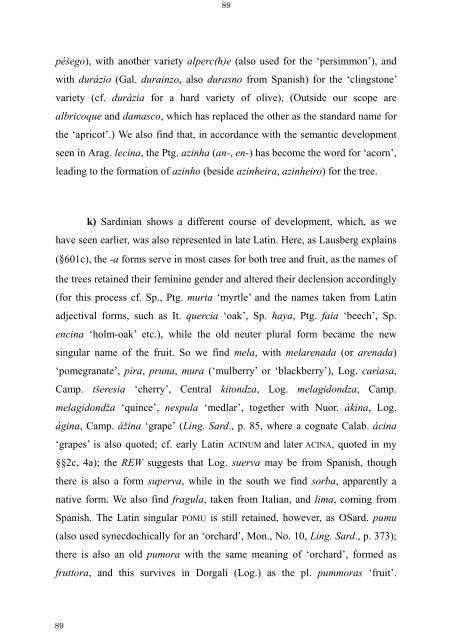The Latin Neuter Plurals in Romance - Page ON
The Latin Neuter Plurals in Romance - Page ON
The Latin Neuter Plurals in Romance - Page ON
Create successful ePaper yourself
Turn your PDF publications into a flip-book with our unique Google optimized e-Paper software.
89<br />
89<br />
péšego), with another variety alperc(h)e (also used for the ‘persimmon’), and<br />
with durázio (Gal. dura<strong>in</strong>zo, also durasno from Spanish) for the ‘cl<strong>in</strong>gstone’<br />
variety (cf. durázia for a hard variety of olive). (Outside our scope are<br />
albricoque and damasco, which has replaced the other as the standard name for<br />
the ‘apricot’.) We also f<strong>in</strong>d that, <strong>in</strong> accordance with the semantic development<br />
seen <strong>in</strong> Arag. lec<strong>in</strong>a, the Ptg. az<strong>in</strong>ha (an-, en-) has become the word for ‘acorn’,<br />
lead<strong>in</strong>g to the formation of az<strong>in</strong>ho (beside az<strong>in</strong>heira, az<strong>in</strong>heiro) for the tree.<br />
k) Sard<strong>in</strong>ian shows a different course of development, which, as we<br />
have seen earlier, was also represented <strong>in</strong> late <strong>Lat<strong>in</strong></strong>. Here, as Lausberg expla<strong>in</strong>s<br />
(§601c), the -a forms serve <strong>in</strong> most cases for both tree and fruit, as the names of<br />
the trees reta<strong>in</strong>ed their fem<strong>in</strong><strong>in</strong>e gender and altered their declension accord<strong>in</strong>gly<br />
(for this process cf. Sp., Ptg. murta ‘myrtle’ and the names taken from <strong>Lat<strong>in</strong></strong><br />
adjectival forms, such as It. quercia ‘oak’, Sp. haya, Ptg. faia ‘beech’, Sp.<br />
enc<strong>in</strong>a ‘holm-oak’ etc.), while the old neuter plural form became the new<br />
s<strong>in</strong>gular name of the fruit. So we f<strong>in</strong>d mela, with melarenada (or arenada)<br />
‘pomegranate’, pira, pruna, mura (‘mulberry’ or ‘blackberry’), Log. cariasa,<br />
Camp. tšeresia ‘cherry’, Central kitondza, Log. melagidondza, Camp.<br />
melagidondža ‘qu<strong>in</strong>ce’, nespula ‘medlar’, together with Nuor. ák<strong>in</strong>a, Log.<br />
ág<strong>in</strong>a, Camp. áž<strong>in</strong>a ‘grape’ (L<strong>in</strong>g. Sard., p. 85, where a cognate Calab. ác<strong>in</strong>a<br />
‘grapes’ is also quoted; cf. early <strong>Lat<strong>in</strong></strong> ACINUM and later ACINA, quoted <strong>in</strong> my<br />
§§2c, 4a); the REW suggests that Log. suerva may be from Spanish, though<br />
there is also a form superva, while <strong>in</strong> the south we f<strong>in</strong>d sorba, apparently a<br />
native form. We also f<strong>in</strong>d fragula, taken from Italian, and lima, com<strong>in</strong>g from<br />
Spanish. <strong>The</strong> <strong>Lat<strong>in</strong></strong> s<strong>in</strong>gular POMU is still reta<strong>in</strong>ed, however, as OSard. pumu<br />
(also used synecdochically for an ‘orchard’, Mon., No. 10, L<strong>in</strong>g. Sard., p. 373);<br />
there is also an old pumora with the same mean<strong>in</strong>g of ‘orchard’, formed as<br />
fruttora, and this survives <strong>in</strong> Dorgali (Log.) as the pl. pummoras ‘fruit’.









